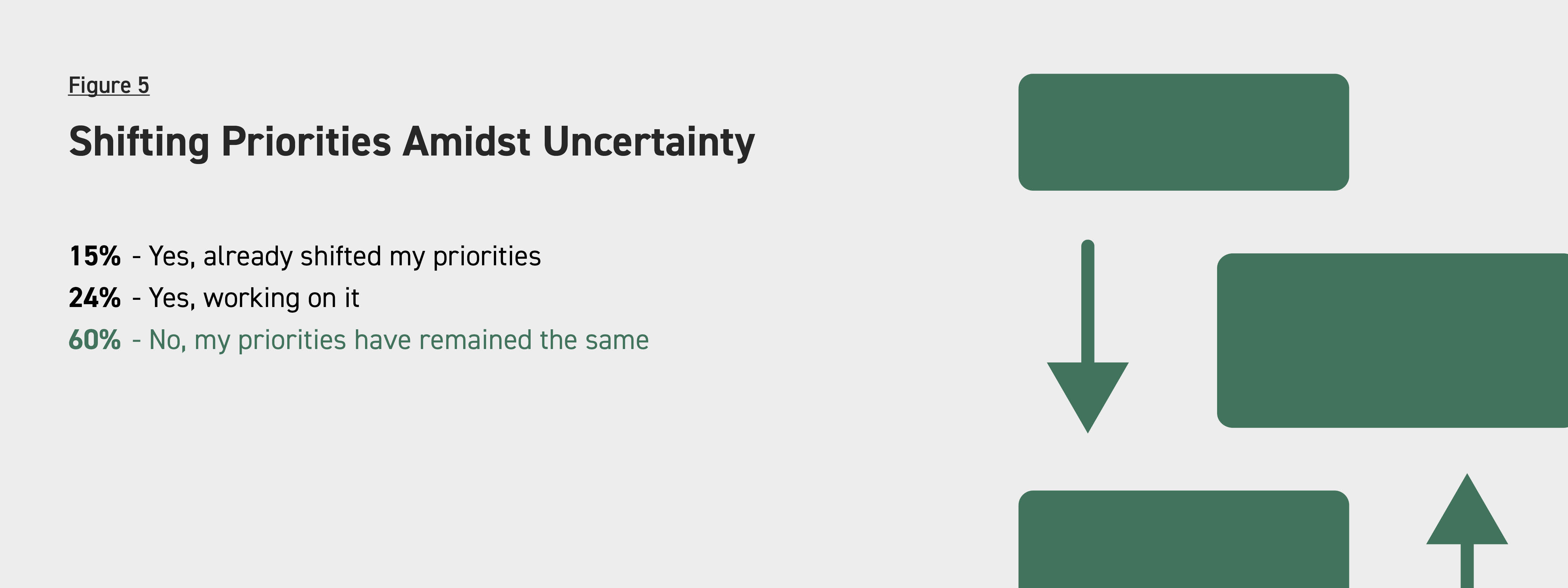In today’s volatile, uncertain, complex, and ambiguous (VUCA) environment, C-level executives are recalibrating their strategic decisions to optimize costs and enhance resilience against business disruptions. Our annual Leadership Perspective Survey highlights this, as CIOs, CISOs, CHROs, CDAOs and CFOs unanimously identify cost reduction as one of their top enterprise priorities for 2025. A recent Gartner poll echoes these findings, noting that “half of C-suite executives are considering cuts to their function in the second quarter of 2025, in anticipation of continued disruption of supply chains, decreased consumer demand and inflation.”
In our survey from early April 2025, “C-suite Community Pulse on Global Unrest and Its Impact on Your Business,” 700 C-level executives shared their insights on the current geopolitical and economic landscape and the strategic shifts they are implementing in response. Below, we outline nine key trends from the survey, including the unique impact the VUCA environment has on each function.
Trend 1: Tariffs are the top economic factor influencing business decisions
Executives identified a range of economic factors impacting their businesses in early 2025, with tariffs and trade implications leading the list, affecting 16% of respondents. Inflation and government regulations closely follow, impacting 14% of executives each. Labor issues affect 11%, and supply chain disruptions impact 10%, among others.

Regionally, tariffs and trade implications have a greater impact on North American executives, with 18% citing it as a business concern. For executives in Europe, the Middle East, and Africa (EMEA), government regulations and inflation are the primary concerns, each affecting 14% of executives. In the survey comments, executives also highlighted concerns about customer spending habits, federal funding, and investor confidence, with one noting, "Pervasive uncertainty limits spending, lending, and borrowing."
Trend 2: Currently, the C-suite has a negative sentiment about the economy and believes a recession is likely in 2025
Nearly two-thirds of C-level executives (61%) express negative sentiments towards the current geopolitical and economic climate. Meanwhile 32% are neutral, and only 7% have a positive outlook.

From a role perspective, CIOs express the most concern, with 66% reporting negative sentiments. Regionally, EMEA executives report a more negative outlook compared to their North American counterparts, with 70% expressing negative sentiments versus 58% in North America. One executive highlighted their frustration, stating, "You cannot adequately plan for anything."

Additionally, 79% of executives believe a global recession is likely or very likely this year. Eleven percent are unsure, and only 10% do not believe a recession will occur. CISOs express the highest concern at 84%.
Despite this, executives have a more optimistic outlook for the second half of the year. Positive sentiments increase from 7% to 20%. Negative sentiments reduce from 61% to 46%.

Trend 3: Technology leaders are doubling down on their strategic priorities, while CHROs are shifting their focus
Despite the VUCA environment, 60% of C-level executives are maintaining their original priorities for 2025. Among the 40% who are altering their priorities, 15% have already revised their plans, while 24% are in development phases.

Technology leaders, particularly CIOs and CISOs, are steadfast in their priorities, focusing on growth, cost optimization, and efficiency. On a functional level, CIOs are prioritizing cybersecurity, AI capabilities, and data and analytics, while CISOs emphasize cyber resilience as their top mission critical priority for 2025.
Conversely, CHROs are adjusting their priorities, with half of HR leaders reporting either already having shifted or in the process of revising them. In early 2025, their focus areas include leader and manager development, organizational culture, and strategic workforce planning. In the survey comments, CHROs were candid about how they are reshaping their priorities. One CHRO said, “New revenue streams, strategic workforce development and retention.” Another shared, “We’re dealing with changes in immigration policy, as well as changing perceptions on DEI.”
Trend 4: Executives are prioritizing investments this year
Regardless of whether they are altering their mission-critical priorities, executives are considering strategic actions to navigate the VUCA environment. Approximately 24% are prioritizing investments, 20% are engaging in scenario planning, and 19% are implementing budget cuts.

In the comments, many executives emphasized business agility, cost reduction, AI investments and postponing growth plans as strategic actions they are taking this year. One executive noted, “We are implementing more cost controls and looking for solutions that optimize our workforce. That has a higher priority now over business expansion.”
Another shared, “We’re still focused on digital transformation, but slowing some of this work. Also, I have started a task force to manage tariffs and their impact on our business.” Another executive commented, “We’re reducing expenses, not starting planned projects, and we’re reviewing projects that will bring operational efficiency immediately.”
Diverse Impacts of the VUCA Environment on Business Functions
While financial constraints are prevalent across the C-suite, the nuances of the VUCA environment affect each function differently. Click the links below to explore the trends affecting each C-level role:
Trend 5: CIOs confront budget constraints, cybersecurity challenges, and innovation hurdles
In the survey, executives were asked about the impact of the VUCA environment on their function. CIOs report facing tighter budgets and financial limitations, leading to a reprioritization of projects for many. Others shared how their focus is shifting towards cost efficiency rather than innovation and growth, impacting technology investments and infrastructure upgrades. Additionally, CIOs express heightened concerns around cybersecurity in the current volatile environment. Here is a sample of their comments:
For technologists, we're faced with more demand to address ways technology can help the business areas reduce costs, while we're faced with cost controls ourselves.
Cyber security and data analysis budgeting gets pushed to the side for immediate gains/wins, but this can set the organization back in the future.
Data and analytics – How can we help our business with greater visibility to raw material prices, supply chain challenges, and faster real-time access to their data for improved timely decision making.
Existing customers spending less with us will result in increased initiatives to cut costs – most likely resulting in layoffs and spending cuts affecting infrastructure upgrades or modernizations.
Trend 6: CISOs tackle escalating cyber threats with limited resources
CISOs anticipate budget cuts and financial constraints will impact their plans to enhance security postures and invest in new technologies. They emphasize how financial limitations are affecting their ability to onboard new staff, tools and capabilities, delaying security improvements and modernization efforts. This is particularly concerning for CISOs as the threat landscape increases and an emphasis on AI technologies brings additional security challenges. Here is a sample of comments from CISOs on this topic:
In a VUCA environment, cybersecurity faces the greatest impact as evolving threats, rapid tech shifts, and regulatory complexity demand constant adaptation and resilience.
Continued demand for using AI and AI-based solutions will have impacts on security, compliance, and technology.
Increased risk of attack due to economic uncertainty, as well as the probability of projects being postponed.
Staff morale – as a reduced budget doesn't mean less is expected of them with the less of them that I have to operate with.
Trend 7: CHROs navigate budget pressures, employee wellbeing, and workforce planning
CHROs highlight that budgetary constraints are leading to cuts in necessary investments, such as technology and infrastructure, affecting long-term planning and strategic initiatives. They also express concern about maintaining employee engagement and wellbeing amidst uncertainty. Talent management is another challenge for CHROs as many are considering potential restructuring and headcount reductions. Here are a few comments from CHROs on the impact of the economic environment on their function:
Being in HR, the concern about the effect on labor is a challenge. Personal finance affects employees greatly so we will need to show ways that they can manage their finances during these uncertain times.
We’re reprioritizing from positive strides on HR supporting culture and employee engagement to shifting to workforce preparedness and downsizing potentials.
Spending cuts affect technology investments within the HR function. We’re examining where additional tech spend has the ROI to reduce headcount needs and slow headcount growth and improve effectiveness of leaders so we better retain and develop top talent.
The ability to keep our people focused on the opportunities that chaos may bring, and where to build in the future, rather than be distracted by the short term.
Trend 8: CDAOs enhance D&A efforts to support strategic planning and AI
In the VUCA environment, CDAOs are witnessing a growing demand for data-driven solutions, with a particular focus on leveraging AI and automation to boost efficiency and maintain competitiveness. However, many CDAOs acknowledge the challenge of balancing innovative initiatives with the constraints of tight budgets and limited resources. Here are a few insights from CDAOs:
Data and analytics will become even more important in decision making and strategic planning. AI and automation will become a necessity for labor efficiency.
Providing timely information and insights to our teams so they can be informed of market conditions and be competitive.
We're moving into an environment with less room to experiment. All efforts need to be driving very short-term returns as budgets tighten.
After years of underinvestment, the business begins looking to the data & analytics function to wave a magic wand!
Trend 9: CFOs prioritize scenario planning, data and analytics, and cash management
CFOs express deep concern about navigating financial uncertainty and ensuring effective cash management. The unpredictability of financial markets necessitates robust scenario planning and data analytics for better decision-making and achieving desired financial outcomes. Here are a few comments from CFOs on the impact of today’s economic environment:
In finance, there is a need to run a wide range of scenarios when making decisions and offering guidance.
Increased scenario planning and evaluation of different operating models to achieve targeted results.
Concern over current and future cuts in government funding.
Keeping the workforce motivated and positive in the face of all of the volatility and uncertainty.
As the C-suite continues to adapt to the evolving challenges of the VUCA environment, their focus remains on maintaining operational stability while preparing for future growth opportunities. If you are a C-level executive navigating economic uncertainty, consider joining Gartner C-level Communities to discuss tactics for addressing these challenges with your peers. If you are already a member, sign in to our app to find your community’s next gathering.
Based on 680 responses to Gartner C-level Communities’ Community Pulse Survey, April 2025.
Join a community
Find your local community and explore the benefits of becoming a member.





